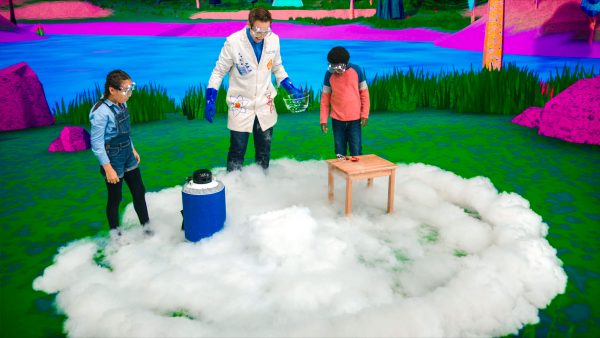Snow Definition
Snow occurs when rain freezes into a solid while it's falling from the sky. For example, cold conditions transform precipitation into snow.
View Lesson on Introduction to Weather
Become a member to get full access to our entire library of learning videos, reading material, quiz games, simple DIY activities & more.
Become a member to get full access to our entire library of learning videos, quiz games, & more.
Plans & Pricingto watch this full video.

Access All Videos
and Lessons, No Limits.
Access All Videos

No credit card required,
takes 7 sec to signup.
No card required

Ready-to-go lessons
that save you time.
Ready-to-go lessons
If you are on a school computer or network, ask your tech person to whitelist these URLs:
*.wistia.com, fast.wistia.com, fast.wistia.net, embedwistia-a.akamaihd.net
Sometimes a simple refresh solves this issue. If you need further help, contact us.
Introduction to Weather
Fun Facts
- Weather is the combination of snow, sunlight, wind, and temperature in a particular region at a particular time.
- Snow is made of frozen water.
- Snow is frozen rain accumulating on the ground.
Why Do We Need To Know About Snow
Learning about snow helps us know more about the weather. It’s important to predict when it’s going to snow. This is important not just for people who work in farming, transportation, and planning outdoor events. They need this information to make smart choices to keep people safe and to use their resources wisely.
Knowing about snow helps us take care of our water supplies, reduce the risk of disasters, and work on protecting the environment. Studying snow and how it affects things is key for preventing dangerous avalanches, and dealing with floods caused by snow melting. Learning about the weather is useful for many real-life situations.
Frequently Asked Questions
Check out the Full Lesson on Introduction to Weather
In this lesson, we learn that:
- Weather tells us what the sky and air around us are like on any given day.
- The weather can be sunny, cloudy, windy, rainy, stormy or snowing.
- Scientists can predict the weather by understanding patterns.
Related Topics
- Adaptation Definition
- Analog Signal Definition
- Bacteria Definition
- Bioindicator Definition
- Carbon Dioxide Definition
- Chemical Change Definition
- Collision Definition
- Comparative Anatomy Definition
- Convection Definition
- Definition Of Engineering
- Definition Of Extreme Weather
- Definition Of Living Things
- Digestive System Definition
- Earth’s Orbit Definition
- Ecosphere Definition
- Energy Transfer Definition
- Engineer Definition
- Evaporation Definition
- Generator Definition
- Geologic Processes Definition
- Gravity Definition
- Group Behavior Definition
- Hydrosphere Definition
- Inherited Traits Definition
- Lever Definition
- Melting Definition
- Molecule Definition
- Non-renewable Resource Definition
- Ocean Current Definition
- Pendulum Definition
- Phases Of The Moon Definition
- Physical Change Definition
- Pollution Definition
- Precipitation Definition
- Predation Definition
- Property Definition
- Rain Definition
- Rain Gauge Definition
- Sediment Filter Definition
- Sedimentary Rock Definition
- Seed Dispersal Definition
- Snow Definition
- Sun Definition
- Tides Definition
- Watershed Definition
- Wave Reflection Definition
- Weather Definition
- Weathering Definition


Start a Free Trial Today. Get a $5 Amazon Gift Card!
Teachers! Start a free trial & we'll send your gift card within 1 day. Only cards left. Try it now.
Select Grade
Select Subject
This email is associated with a Science Kit subscription. Kit subscriptions are managed on this separate page: Manage Subscription

-
Download InvoiceScience & Math$/yr
-
Download InvoiceScience Only$/yr

access all lessons
• No credit card required •
"My students loved the videos. I started the video subscription in May and used them as a review before the state test, which I know contributed to 100% of my class passing the state test."
Rhonda Fox 4th Grade Teacher, Ocala, Florida
Use Generation Genius in Your School
Access all lessons free for 30 days.
"My students loved the videos. I started the video subscription in May and used them as a review before the state test, which I know contributed to 100% of my class passing the state test."
Rhonda Fox 4th Grade Teacher, Ocala, Florida
• No credit card required •
Already a member? Sign In
* no credit card required *

* no credit card required *
* no credit card required *

Get District Quote
Discounts start at 3 schools.
Sent!
Thank you for your inquiry.
We will email you a quote as soon as we can.

to Discover the Benefits of Generation Genius
Learn How to Save for Your School & District!
Please login or create an account to access additional resources

no credit card required
Skip, I will use a 3 day free trial
Enjoy your free 30 days trial
-
Unlimited access to our full library
of videos & lessons for grades K-5. -
You won’t be billed unless you keep your
account open past your 14-day free trial. -
You can cancel anytime in 1 click on the
manage account page or by emailing us.
-
Unlimited access to our full library of videos & lessons for grades K-5.
-
You won't be billed unless you keep your account open past 14 days.
-
You can cancel anytime in 1-click on the manage account page.
Cancel anytime in 1-click on the manage account page before the trial ends and you won't be charged.
Otherwise you will pay just $10 CAD/month for the service as long as your account is open.
Cancel anytime on the manage account page in 1-click and you won't be charged.
Otherwise you will pay $10 CAD/month for the service as long as your account is open.
We just sent you a confirmation email. Enjoy!
Done



























































































































 GENERATION GENIUS
GENERATION GENIUS